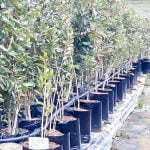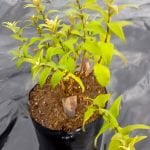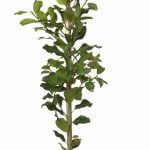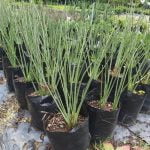Showing 2041–2052 of 2112 resultsSorted by popularity
- Sale!

Syzygium Guineense Tall Tree 20lt
Original price was: R595.00.R425.00Current price is: R425.00.Add to cartSyzygium Guineense Tall Tree 20lt
Common Name: Waterpear TreeFull Sun
Indigenous
Evergreen
Low Watering
Hedging Tree
Drought Tolerant
Wind TolerantSyzygium guineense, commonly known as Waterberry, Water Pear, or African Waterpear, is a species of tree belonging to the Myrtaceae family. It is native to various regions in Africa, including parts of West Africa, East Africa, and southern Africa. The Waterberry tree is valued for its edible fruits and is often found growing near water sources, such as rivers and lakes.
Appearance: Syzygium guineense is a medium-sized to large tree that can reach heights of 10 to 30m. It has a rounded crown with dense foliage.
Leaves: The leaves of the Waterberry tree are simple, opposite, and elliptical in shape. They are dark green and have a glossy appearance.
Flowers: The tree produces small, cream-colored or white flowers that are arranged in panicles or clusters. The flowers are usually not showy but are an important source of nectar for pollinators.
Fruits: The most significant feature of Syzygium guineense is its edible fruit, which is known as Waterberry or Water Pear. The fruits are small, round, and turn from green to purple-black when ripe. They have a sweet and slightly tart flavour and are enjoyed fresh or used to make jams, jellies, and beverages.
Growth Requirements: Waterberry trees prefer well-draining soil and are commonly found growing in areas with access to water, such as riverbanks and wetlands. They can tolerate both full sun and partial shade.
Uses: The fruits of Syzygium guineense are an important food source for both humans and wildlife, including birds and various mammal species. In some regions, the bark and leaves of the tree have also been used for medicinal purposes.
Wildlife Attraction: The Waterberry tree is attractive to birds and other wildlife, which feed on its fruits and disperse its seeds, contributing to its ecological significance.
- Sale!

Syzygium Guineense bushy 20lt
Original price was: R465.00.R350.00Current price is: R350.00.Add to cartSyzygium Guineense bushy 20lt
Common Name: Waterpear TreeFull Sun
Indigenous
Evergreen
Low Watering
Hedging Tree
Drought Tolerant
Wind TolerantSyzygium guineense, commonly known as Waterberry, Water Pear, or African Waterpear, is a species of tree belonging to the Myrtaceae family. It is native to various regions in Africa, including parts of West Africa, East Africa, and southern Africa. The Waterberry tree is valued for its edible fruits and is often found growing near water sources, such as rivers and lakes.
Appearance: Syzygium guineense is a medium-sized to large tree that can reach heights of 10 to 30m. It has a rounded crown with dense foliage.
Leaves: The leaves of the Waterberry tree are simple, opposite, and elliptical in shape. They are dark green and have a glossy appearance.
Flowers: The tree produces small, cream-colored or white flowers that are arranged in panicles or clusters. The flowers are usually not showy but are an important source of nectar for pollinators.
Fruits: The most significant feature of Syzygium guineense is its edible fruit, which is known as Waterberry or Water Pear. The fruits are small, round, and turn from green to purple-black when ripe. They have a sweet and slightly tart flavour and are enjoyed fresh or used to make jams, jellies, and beverages.
Growth Requirements: Waterberry trees prefer well-draining soil and are commonly found growing in areas with access to water, such as riverbanks and wetlands. They can tolerate both full sun and partial shade.
Uses: The fruits of Syzygium guineense are an important food source for both humans and wildlife, including birds and various mammal species. In some regions, the bark and leaves of the tree have also been used for medicinal purposes.
Wildlife Attraction: The Waterberry tree is attractive to birds and other wildlife, which feed on its fruits and disperse its seeds, contributing to its ecological significance.
- Sale!

Clementine Marisol 20lt
Original price was: R650.00.R399.99Current price is: R399.99.Add to cartClementine Marisol 20lt
Full Sun
Afternoon Sun
Medium Watering
Fruiting - Sale!

Syzygium Cordatum 20lt (Water Berry)
Original price was: R495.00.R379.99Current price is: R379.99.Add to cartSyzygium Cordatum 20lt
Common Name: Water BerryFull Sun
Semi Shade
Medium Watering
Evergreen
IndigenousCompact tree growing up to 10m in height with blue-green leaves and masses of cream-white flowers in Autumn followed by black berries that will attract birds.

Ficus Elastica Robusta 19cm Pot
R450.00Add to cartFicus Elastica Abidjan 24cm
Common Name: Rubber PlantKeep in a brightly lit room with no direct sunlight on the leaves.
Comes in 24cm growing pot and approximately 60-70cm tall.
Crassula Tetragona 17cm
R95.00Add to cartCrassula Tetragona 17cm
Common Name: KarkaiFull Sun
Afternoon Sun
Low Watering
Evergreen
Indigenous
Water WiseHardy succulent shrub that grows with rows of green, sword-shaped leaves. Flowers with cream flowers from Summer to Autumn.
- Sale!

Buddleja salviifolia (Sagewood) 10lt
Original price was: R240.00.R225.00Current price is: R225.00.Add to cartBuddleja salviifolia 10lt
Common Name: SagewoodFull Sun
Afternoon Sun
Low Watering
Evergreen
IndigenousMulti-stemmed shrub growing up to 5m in height with grey-green leaves and scented, white-lilac flowers with an orange throat in Winter and Spring.
- Sale!

Ficus Natalensis (Natal Fig) 20lt
Original price was: R475.00.R350.00Current price is: R350.00.Add to cartFicus Natalensis 20lt
Common Name: Natal FigFull Sun
Semi Shade
Medium Watering
Indigenous
EvergreenA great tree for any subtropical garden, reaching heights of up to 15m. Ideal in pots as well and can be used as an indoor plant in well lit and sunny areas of the home.
They have small leaves and fruit with small figs in the warmer months of Spring and Summer which will attract insects and birds to your garden.
They do have invasive roots so plant in an area where it will be allowed to have room to grow.Ficus natalensis, commonly known as the Natal fig or the river sandpaper fig, is a species of fig tree native to various regions in Africa. It belongs to the Moraceae family, which includes other well-known fig species. Ficus natalensis is a large, evergreen tree that plays a significant ecological role in its native habitats.
Appearance: Ficus natalensis is a substantial tree that can reach heights of 15 to 30m or more. It has a spreading canopy and a dense crown of glossy green leaves.
Leaves: The leaves of Ficus natalensis are large, thick, and elliptical with prominent veins. They have a rough texture, which gives rise to the common name “river sandpaper fig.” The leaves are arranged alternately along the branches.
Figs: Like all fig trees, Ficus natalensis produces a unique fruit known as a syconium, which is a specialized structure that houses the flowers inside. These figs are an important food source for various animals, including birds and mammals, and play a role in the tree’s dispersal and reproduction.
Ecological Importance: Ficus natalensis is ecologically important in its native range as it provides food and habitat for various wildlife species. Many animals, including birds and monkeys, feed on its fruits, and some insects rely on the tree for shelter and breeding sites. Additionally, fig trees are well-known for their symbiotic relationship with fig wasps, which are crucial for pollination.
Distribution: The Natal fig is native to a wide range of countries in Africa, including South Africa, Mozambique, Zimbabwe, Zambia, and Tanzania.
Landscape Use: In some regions, Ficus natalensis is used as an ornamental tree for its large, attractive foliage and shade-providing qualities. However, due to its large size, it is generally more suitable for larger gardens or parkland areas.
- Sale!

Almond Tree (Prunus Dulcis) 20lt
Original price was: R650.00.R379.99Current price is: R379.99.Select options This product has multiple variants. The options may be chosen on the product pagePrunus Dulcis 20lt
Common Name: Almond TreeFull Sun
Semi Shade
Medium WateringGrow to about 4m-6m in height with pink/white flowers in Spring. They fruit after flowering and the fruit will then mature and open up to reveal the nut which is covered by a hard shell.
Remember you will need to plant 2 type for proper fruiting otherwise the tree may not bear fruit.
- Sale!

Aloe Chabaudii 10lt
Original price was: R285.00.R195.00Current price is: R195.00.Add to cartAloe Chabaudii 10lt
Full Sun
Semi Shade
Evergreen
Water Wise
Low Watering
IndigenousThis wonderful water wise succulent is a clump-forming aloe with grey/green leaves.
They flower in Winter with coral red flowers.
They attract birds and insects so a wonderful addition to any bird lovers garden. 
Cyathea Australis Fern 20lt
R550.00Add to cartCyathea Australis Fern 20lt
Common Name: Australian Tree FernSemi Shade
Shade
Medium Watering
EvergreenFast-growing tree fern up to 4m in height with a rough, hairy stem and leaves in rosette.
Moist and shady conditions are a favourite for this fern.Cyathea australis, commonly known as the Rough Tree Fern or the Australian Tree Fern, is a large and attractive species of tree fern native to eastern Australia, particularly in the coastal regions of New South Wales and Queensland. It is a member of the Cyatheaceae family.
Characterized by its tall, slender trunk and large fronds, Cyathea australis can grow up to 15 meters in height. The fronds are bright green and can reach lengths of 4-6 meters, forming a beautiful canopy of lush foliage.
These ferns prefer shady and moist environments, typically found in rainforests, gullies, and other sheltered areas. They are well-suited to gardens with a similar environment, making them popular choices for landscaping projects in suitable climates.
When planting Cyathea australis, it is essential to ensure the soil is rich and well-draining, and the location provides enough shade and protection from strong winds. Regular watering is crucial to maintaining their lush appearance. In colder regions, they may require additional protection during winter.

Strelitzia Juncea 20lt
R650.00Add to cartStrelitzia Juncea 20lt
Full Sun
Semi Shade
Low Watering
Drought Tolerant
Water Wise
Indigenous












